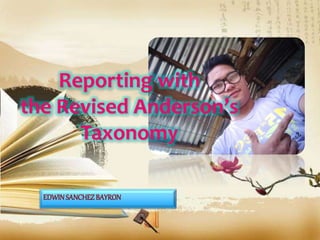
Anderson taxonomy
- 1. Reporting with the Revised Anderson’s Taxonomy EDWINSANCHEZBAYRON
- 2. Classification of thinking Six cognitive levels of complexity Taxonomy = Classification
- 6. Why use Anderson’s taxonomy? Write and revise learning objectives Plan curriculum Identifies simple to most difficult skills Effectively align objectives to assessment techniques and standards
- 7. • Incorporate knowledge to be learned (knowledge dimension) and cognitive process to learn • Facilitate questioning (oral language = important role within framework) Why use Anderson’s taxonomy?
- 11. Analyzing Applying Creating Evaluating Remembering Understanding Cognitive Domain Characterizing by value or value concept Organizing & conceptualizing Receiving Responding Valuing Affective Domain Psychomotor Domain Articulating Imitating Manipulating Performing Precisioning
- 12. Analyzing Applying Creating Evaluating Remembering Understanding Cognitive Domain Characterizing by value or value concept Organizing & conceptualizing Receiving Responding Valuing Affective Domain Psychomotor Domain Articulating Imitating Manipulating Performing Precisioning
- 13. Categories noun to verb Taxonomy reflects different forms of thinking (thinking is an active process) verbs describe actions, nouns do not Reorganized categories Knowledge = product/outcome of thinking (inappropriate to describe a category of thinking) now remembering Comprehension now understanding Synthesis now creating to better reflect nature of thinking described by each category Change in Terms
- 14. Products of thinking part of taxonomy Forms of knowledge = factual, conceptual, procedural, metacognitive (thinking about thinking) Synthesis (creating) and evaluation (evaluating) interchanged Creative thinking more complex form of thinking than critical thinking (evaluating) Changes in Structure Handout #
- 15. USE: More authentic tool for curriculum planning, instructional delivery and assessment Aimed at broader audience Easily applied to all levels of education Revision emphasizes explanation and description of subcategories Changes in Emphasis Handout #
- 17. Remembering The learner is able to recall, restate and remember learned information Describing Finding Identifying Listing Retrieving Naming Locating Recognizing Can students recall information?
- 18. Can students explain ideas or concepts?
- 19. Understanding Student grasps meaning of information by interpreting and translating what has been learned Inferring Interpreting Paraphrasing Summarizing Can students explain ideas or concepts? Classifying Comparing Exemplifying Explaining
- 20. Can students use the information in another familiar situation?
- 21. Applying Student makes use of information in a context different from the one in which it was learned Implementing Carrying out Using Executing Can students use the information in another familiar situation? c =
- 22. Can students break information into parts to explore understandings and relationships?
- 23. Analyzing Student breaks learned information into its parts to best understand that information Attributing Comparing Deconstructing Finding Integrating Organizing Outlining Structuring Can students break information into parts to explore understandings and relationships?
- 24. Can students justify a decision or a course of action?
- 25. Evaluating Student makes decisions based on in-depth reflection, criticism and assessment Checking Critiquing Detecting Experimenting Hypothesising Judging Monitoring Testing Can students justify a decision or a course of action?
- 26. Can students generate new products, ideas, or ways of viewing things?
- 27. Creating Student creates new ideas and information using what previously has been learned Constructing Designing Devising Inventing Making Planning Producing Can students generate new products, ideas, or ways of viewing things?
- 28. Lower level questions—remembering, understanding & lower level applying levels Lower level questions Evaluate students’ preparation and comprehension Diagnose students’ strengths and weaknesses Review and/or summarizing content Questioning . . .
- 29. Higher level questions require complex application, analysis, evaluation or creation skills Higher level questions Encourage students to think more deeply and critically Facilitate problem solving Encourage discussions Stimulate students to seek information on their own Questioning . . .
- 30. What happened after...? How many...? What is...? Who was it that...? Name ... Find the definition of… Describe what happened after… Who spoke to...? Which is true or false...? “Remembering” stems
- 31. Explain why… Write in your own words… How would you explain…? Write a brief outline... What do you think could have happened next...? Who do you think...? What was the main idea...? Clarify… Illustrate… “Understanding” stems
- 32. Explain another instance where… Group by characteristics such as… Which factors would you change if…? What questions would you ask of…? From the information given, develop a set of instructions about… “Applying” stems
- 33. Which events could not have happened? If. ..happened, what might the ending have been? How is...similar to...? What do you see as other possible outcomes? Why did...changes occur? “Analyzing” stems
- 34. Explain what must have happened when... What are some or the problems of...? Distinguish between... What were some of the motives behind..? What was the turning point? What was the problem with...? “Applying” stems
- 35. Judge the value of... What do you think about...? Defend your position about... Do you think...is a good or bad thing? How would you have handled...? What changes to… would you recommend? Do you believe...? How would you feel if...? “Evaluating” stems (Pohl, 2000)
- 36. How effective are...? What are the consequences...? What influence will....have on our lives? What are the pros and cons of....? Why is....of value? What are the alternatives? Who will gain & who will loose?
- 37. Design a...to... Devise a possible solution to... If you had access to all resources, how would you deal with...? Devise your own way to... What would happen if ...? How many ways can you...? Create new and unusual uses for... Develop a proposal which would... “Creating” stems
- 38. Systematic process of thinking & learning Assists assessment efforts with easy-to-use format Visual representation of alignment between goals & objectives with standards, activities, & outcomes Helps form challenging questions to help students gain knowledge & critical thinking skills Assists in development of goals, objectives, & lesson plans Summary Bloom’s revised taxonomy
- 39. Thank You!!!!!!